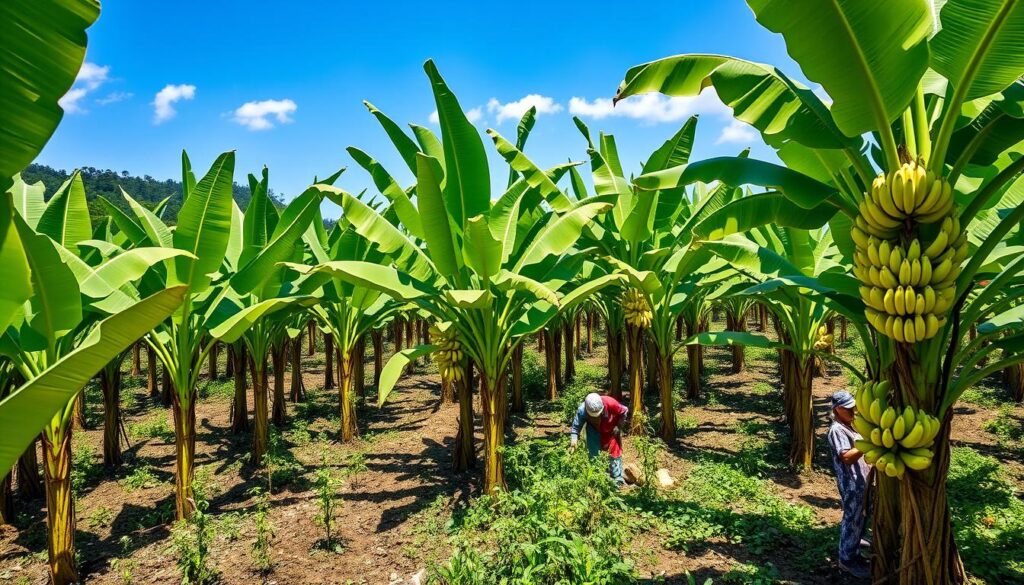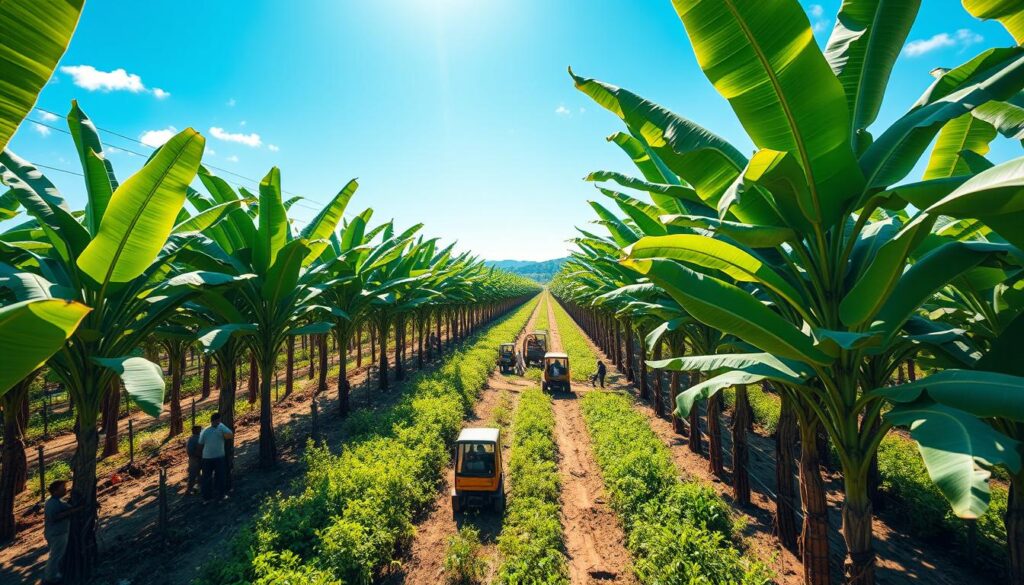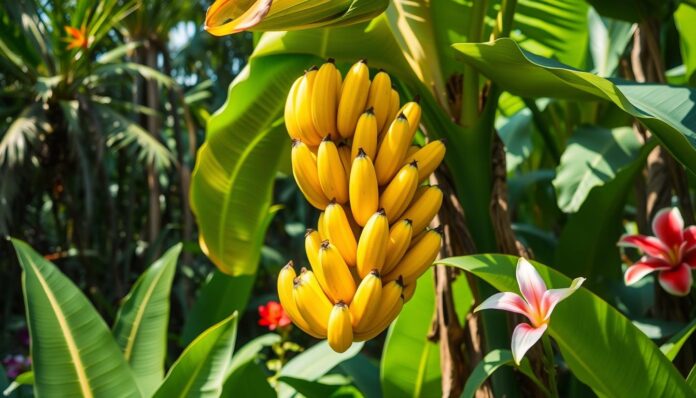The allure of first bananas stretches beyond their sweet taste. These early-harvested tropical fruits carry a deep history in banana farming. They’re admired in homes and restaurants for their unique flavor, making their journey from the farm to our tables exciting. As we uncover their significance, we find they’re essential in many dishes. They offer not only nourishment but also a joyous experience. This connects us with the abundance of nature.
Key Takeaways
- First bananas are among the earliest harvested tropical fruits.
- Their sweetness and unique flavor make them a popular choice.
- Understanding banana cultivation enhances appreciation for these fruits.
- First bananas play a key role in culinary dishes worldwide.
- The journey from banana farm to table celebrates sustainable farming practices.
The Origin of Bananas
Bananas have a history that is both interesting and long. They first appeared in Southeast Asia, thousands of years ago. Wild ancestors of bananas grew in rich forests. Each early banana was unique in taste and look.
Ancient cultures found these fruits and started growing them. Bananas became more than just food; they were part of many culinary traditions. As they were traded across continents, more people discovered bananas.
Bananas’ spread changed their genetic makeup. Selective breeding led to many new types. These varieties could grow in different climates worldwide. This made bananas a popular choice in many places.
Knowing where bananas come from helps us understand their role in agriculture and the economy. Their long journey adds to our enjoyment of them today.
The Importance of First Bananas in Cultivation
First bananas are very important in banana farming. They are a key part of farming in many countries. These bananas offer farmers a steady income and are crucial for local economies, especially in tropical areas.
They also add variety to diets and help with food security. The growing of first bananas produces a lot of food. This is vital for feeding people in various places.
Farmers depend a lot on this crop. It’s clear in places where first bananas are a big part of what people eat and sell. For many, they are the main source of nutrition.
Let’s look at some numbers that show how important first bananas are:
| Region | Annual Banana Production (metric tons) | Percentage of First Bananas |
|---|---|---|
| Latin America | 30,000,000 | 40% |
| Africa | 14,000,000 | 60% |
| Asia | 50,000,000 | 30% |
The data shows the big role of first bananas in farming. Farming these bananas is linked to both local and global markets. It’s not just about food.
Farmers growing them support their communities. They manage to keep going strong even when economics change.
Understanding the Growing Process
Banana cultivation has several key phases. Each one is vital for successful growth. It’s a journey from seedlings to mature plants ready for harvest. Every stage needs close attention, especially to weather, which greatly affects growth.
The Stages of Banana Growth
The growth of banana plants goes through specific stages:
- Planting: Seeds or suckers are planted in rich soil.
- Vegetative Growth: The plant grows roots and leaves.
- Flowering: Flowers appear, leading to fruit.
- Fruit Development: Bananas grow and ripen on the plant.
- Harvesting: Ripe bananas are picked for eating and selling.
The Role of Weather Conditions
The success of growing bananas depends a lot on the weather. Important factors include:
- Temperature: Growth is best between 75°F and 95°F.
- Rainfall: Bananas need about 40 to 100 inches of rain a year.
- Sunlight: They love full sun and lots of light.
Bad weather can harm the growth stages, resulting in fewer bananas. Farmers must adjust their methods, particularly with changing climates.

| Growth Stage | Description | Weather Impact |
|---|---|---|
| Planting | Initiation of growth using seeds or suckers. | Requires warm temperatures and adequate moisture. |
| Vegetative Growth | Development of leaves and roots. | Optimal growth at moderate temperatures with consistent rain. |
| Flowering | Formation of flowers leading to fruit. | Stable weather to prevent damage is essential. |
| Fruit Development | Bananas grow, maturing on the plant. | Warm temperatures and humidity foster development. |
| Harvesting | Picking of ripe bananas. | Timely harvest requires monitoring weather patterns. |
Exploring Green Bananas
Green bananas, often considered unripe, are unique compared to ripe bananas. Learning about their unripe stage and health benefits can make us appreciate them more.
When Are Bananas Considered Unripe?
Bananas are picked when green, with more starch than sugar. This happens because they are harvested in a grown stage. They are usually picked 75 to 85 days after flowering, showing a green skin and firm texture.
Health Benefits of Eating Green Bananas
Eating green bananas offers great health benefits. They are full of resistant starch, which helps our gut health. Also, they have a lot of fiber, making our digestion better.
Green bananas are packed with vitamins C and B6, potassium, and magnesium. They fit well into many diets and cuisines. This makes them a top choice for those who care about health.
Plantain Bananas: A Comparative Look
Plantain bananas are different from sweet bananas. They are starchier and used in savory meals. This makes them very special in cooking.
In a lot of places, plantains are very important. People boil, fry, or bake them. They work great as a side dish or base for recipes. Because they’re starchy, they soak up flavors well.
Plantain farming is very important in West Africa and the Caribbean. It’s a key food source and creates jobs. With growing demand, plantains are now used in new, creative recipes. This has made them more popular worldwide.
- Baked plantains: A sweet option with different toppings.
- Fried plantains: Crispy outside and soft inside, often a favorite side.
- Mash: Perfect with toppings, adding rich flavor and texture.
Plantains enrich cultural dishes, making them a vital part of diets globally.
Banana Harvest: Timing and Techniques
The banana harvest is a key time for farmers. It affects how much and how good the crop is. The right timing is crucial for the best taste and longest shelf-life. Good farming methods also improve the amount of bananas harvested.
Best Practices for Banana Farmers
To have a great banana harvest, farmers need to follow some important tips. These include:
- Watching the growth stages to pick at the best time.
- Handling the bananas carefully to avoid bruises and damage while moving them.
- Keeping tools and equipment clean to stop diseases.
Using these farming techniques helps farms work better. It also makes the bananas better.
Impact on Initial Banana Yield
Several things affect the first amount of bananas a farm can get. These are:
- The quality of the soil which helps plants grow and bananas develop.
- How well the farm keeps the plants watered.
- Spacing the banana plants right so they get enough sun and air.
A study of a good farm showed paying attention to these things really paid off. The farm got lots more bananas at first.
| Aspect | Best Practice | Impact on Yield |
|---|---|---|
| Harvest Timing | Monitor growth stages | Maximized flavor |
| Handling Techniques | Prevent bruising | Less waste |
| Soil Quality | Regular testing and amendments | Higher yields |
| Water Management | Consistent irrigation | Healthy plants |
| Plant Spacing | Optimal distance for growth | Enhanced airflow and light |
Various Methods of Banana Cultivation
Banana farming varies greatly, combining old ways and new tricks. Some methods boost output and care for our earth. This is very important for those who want to grow organic bananas.
Regular farming often uses chemicals that might hurt the soil and all living things nearby. But sustainable farming tries to keep a healthy environment. It uses fewer chemicals and protects nature’s gifts.
Let’s look at some key banana cultivation methods focused on being kind to nature:
- Organic Farming: This uses nature’s tools to keep pests away and promote health.
- Permaculture: This method makes farms that work like natural places, which helps soil and plants stay strong.
- Agroforestry: This mixes banana plants with trees. It’s good for shade, food, and homes for helpful creatures.
- Cover Cropping: Planting certain crops between bananas can make the soil better and keep weeds down.
These ways help grow top-notch organic bananas and save our planet. By using new farming ideas, we can provide enough bananas for everyone without harming the earth.
Exploring Early Banana Crop Varieties
Banana cultivation introduces a wide range of early varieties. Each type has unique features and growth needs. These are crucial for banana production worldwide.
Knowing about these varieties shows progress in farming. It highlights better pest resistance and more yield.
Characteristics of Popular Early Varieties
Some early banana varieties stand out to farmers. They are adaptable and yield well. Let’s look at a few:
- Dwarf Cavendish: It grows compactly and matures quickly, making it a top choice for commercial production.
- Apple Bananas: These small, sweet bananas do well in tropical climates. They have unique flavors that attract niche markets.
- Goldfinger: This variety resists disease well, providing a steady yield. It’s popular among farmers who practice sustainable farming.
Impact on Banana Production
Choosing the right early varieties affects banana production. Farmers look at yield, resistance to disease, and growth speed. These choices have led to:
- Better yield rates because of quicker maturation and good growth conditions.
- More market opportunities, as different varieties meet various consumer tastes.
- Less crop loss, thanks to better disease resistance.
| Variety | Growth Habit | Resistance | Maturity Period |
|---|---|---|---|
| Dwarf Cavendish | Compact | Moderate | 9-12 months |
| Apple Bananas | Upright | Low | 8-10 months |
| Goldfinger | Tall | High | 10-12 months |
Each banana variety plays a key role in banana production. Choosing well is important for farmers and consumers alike. By focusing on the right traits, farmers boost productivity. This ensures we all enjoy bananas.
Banana Farming: Trends and Insights
Recently, the banana market has seen big changes, largely because of what consumers want. More people now prefer organic and sustainably-sourced bananas. This has led to new trends in banana farming. Producers are now changing their ways to match these expectations.
Globalization has had a big impact on the banana market. Being part of the global market means farmers need to keep up with new trends. One big trend is the rise in specialty banana products. These products, like unique banana varieties and added-value goods, are popular with health-conscious consumers.
Farmers are now using technology to stay ahead in the competitive world of banana production. Tools like precision agriculture are being used to improve yield and reduce harm to the environment. It’s very important for farmers to know about changes in what consumers want. This helps them stay profitable in the banana market.

The future looks bright for the banana industry as it keeps adapting to market changes. More people are learning about the health benefits of bananas and trying them in new ways. This, combined with other factors, means banana farming is set to grow in the coming years.
Conclusion
As we wrap up, it’s clear that first bananas are key in agriculture and cooking. They have a rich history and are important in today’s diets. They can be used in many ways, making them a favorite worldwide.
Sustainable farming is crucial for bananas’ future. Using innovative methods and caring for the environment helps grow healthy crops. This not only preserves their history but also supports farmers and consumers.
The future of bananas looks bright. With new research and interest in their health benefits, there’s room for innovation. By focusing on sustainability, we can keep bananas thriving for future generations.
